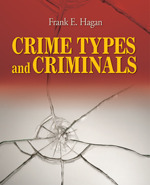CHAPTER 1. Introduction
Fads and Fashions in Crime
The Emergence of Criminology
Mala in Se and Mala Prohibita
Social Change and the Emergence of Law
Consensus vs. Conflict Model of Law
Who Defines Crime? Criminological Definitions of Crime
CHAPTER 2. General Characteristics of Crime and Criminals
Caution in Interpreting Crime Data
International Variations in Crime
Gender Differences in Criminality
Regional Variation in Crime
Criminal Behavior Systems
Theoretical Range and Criminological Explanation
CHAPTER 3. An Overview of Theory in Criminology
Major Theoretical Approaches
Classical and Neo-Classical Theory
Forerunners of Modern Criminological Thought
Mainstream Sociological Theory
Critical Sociological Theory
Integrated Theories of Crime
CHAPTER 4. Violent Crime
History of Violence in the United States
Types of Murders: Multicide
Typology of Violent Offenders
Homicide and Assault Statistics
Patterns and Trends in Violent Crime
Conklin's Typology of Robbers
Criminal Careers of Violent Offenders
Career Criminals/Violent Predators
CHAPTER 5. Property Crime: Occasional, Conventional and Professional
Occasional Property Crimes
Conventional Property Crimes
Arson -- A Special-Category Offense
Criminal Careers of Occasional and Conventional Property Criminals
The Concept of "Professional Crime"
Characteristics of Professional Crime
A Model of Professional Crime
Professional Auto Theft Rings
Criminal Careers of Professionals
CHAPTER 6. White Collar Crime: Occupational and Corporate
White Collar Crime -- The Classic Statement
The Measurement and Cost of Occupational and Corporate Crime
The History of Corporate, Organizational, and Occupational Crime
Organizations and the Law
Crimes by Employees Against Individuals (the Public)
Crimes by Employees Against Employees
Crimes by Employees Against Organizations
Crimes by Individuals (or Members of Occupations)
Crimes by Organizations/Corporations Against Individuals (the Public)
Crimes by Organizations Against Employees
Crimes by Organizations (Corporations) Against Organizations
Criminal Careers of Occupational and Organizational Offenders
Why the Leniency in Punishment?
CHAPTER 7. Political Crime and Terrorism
Political Crime: A Definition
The Universal Declaration of Human Rights
Illegal Surveillance, Disruption, and Experiments
Crimes Against Government
Political "Whistleblowing"
The Oklahoma City Bombing
Criminal Careers of Political Criminals
The Doctrine of Raison d'État
Terrorism and Social Policy
CHAPTER 8. Organized Crime
Organized Crime: A Problematic Definition
Sources of Information on Organized Crime
Types of Organized Crime (Generic Definitions)
The Organized Crime Continuum
International Organized Crime
The Nature of Organized Crime
Ethnicity and Organized Crime
Theories of the Nature of Syndicate Crime in the United States
The Cosa Nostra Theory (The Cressey Model)
The Patron Theory (The Albini Model)
The Italian-American Syndicate (LAS)
The Classic Pattern of Organized Crime
Strategic and Tactical Crimes
Illegal Businesses and Activities
Big Business and Government
A Brief History of Organized Crime in the United States
Criminal Careers of Organized Criminals
Public and Legal Reaction
CHAPTER 9. Public Order Crime
Nuts, Guts, Sluts, and "Preverts"
Nonvictimless Sexual Offenses
Characteristics of Sex Offenders
Drug Use in the United States: The Drug Dip?
The Prohibition Experiment
CHAPTER 10. Computer Crime and the Future of Crime
Predicting the Future of Crime: Methods
The Future of Digital Crime
British Home Office Predictions
